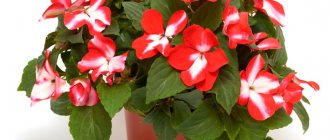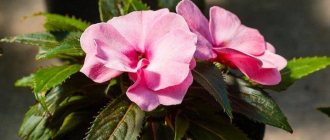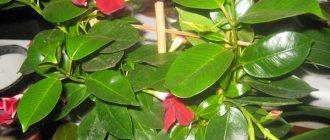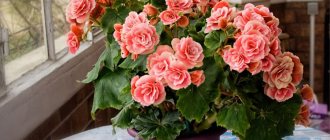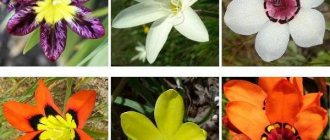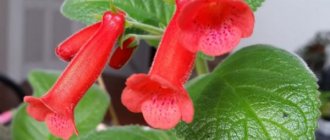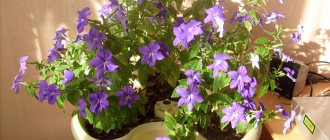Brief description of the flower
In appearance, it is a small bush with erect stems, on which branches with oval leaves, pointed at the base, are densely located. Balsam flowers have irregular shape and texture: there are double and smooth types, solitary or collected in inflorescences. In addition, they have a varied color palette, depending on the type they can be: white, red, pink, orange, coral, or combine two or three colors at the same time. That is why the second name of the home flower is “light”. People also call balsam “Vanka wet” for its love of moisture. In inclement weather, in rain and fog, it really becomes wet - droplets of water, sweet to the taste, form on the sharp edges of its leaves.
In addition to the above, we advise you to read the article about Balsam. It contains information about signs, what it is also called, the characteristics of the plant are given and the most popular varieties are described.
There are several ways to plant balsam: cuttings, seeds, layering. In this article we will consider only one of them, which one - read below. It is worth watering your pet more intensively than other house plants, but you should not allow water to stagnate in the roots! We recommend watering it every one to two days in the summer, and twice a week in the winter.
Types and varieties
Waller's balsam
Modern selection today has created many varieties and hybrids, differing in size and color of flowers and leaves. The founder of most of them is Waller's balsam or Waller . This perennial has green, brownish or reddish stems up to 60 cm long.
It blooms with small (up to 4 cm) bright flowers, single or collected in inflorescences. Miniature Waller's balsam hybrids are covered with a continuous carpet of bright flowers during the flowering period. Another widespread variety is Peter's balsam .
Although quite similar to Waller's balsam, this species is distinguished by its large stems, their slight pubescence and larger bright red flowers. The main difference between Peters' balsam and its relative is the bronze color of the stems and leaves.
Ferruginous balsam is grown as an annual crop for hedges and lawn landscaping. Its peculiarity is the presence of glands - dense formations - at the base of the leaf.
Iron balsam
Reaches a height of 2 meters, the stem is branched and powerful. The flowers are large, collected in umbrellas. The color of the flowers is white, pink, wine red.
New Guinea balsam
New Guinea balsam hybrids have larger, patterned leaves than Waller's balsam and flowers that are bright and varied in color. They are very decorative when grown indoors and delight the eye with flowering all year round.
Planting balsam from cuttings
This plant is absolutely unpretentious, so it is ideal for beginning gardeners. An excellent method of propagation that preserves 100% varietal characteristics is balsam cuttings. There are several vegetative methods for propagating balsam by cuttings:
Rooting in water
We cut off the top of a healthy bush, approximately 8-10 cm with 2-3 internodes (the branch should not have flowers or buds), then remove the lower leaves and place them in a container with water (do not immerse the leaves in water to avoid rotting). Leave the cuttings in a bright, warm place. In 10-14 days it will give roots. Now it can be planted: a small pot with the following contents is suitable for this - compost, humus and turf soil in equal parts. Also, you should not get carried away with abundant fertilization of the seedling, since in the best case, its leaves will grow, to the detriment of flowering; in the worst case, the flower may die completely. You should also be careful with watering: it is best to water along the edge of the flowerpot or into a tray, excluding direct contact with water on the trunk of the plant, as this is fraught with rotting. If you notice that the flower is withering, the flowers and buds are falling off, then most likely this is a signal of insufficient moisture or high water hardness. For irrigation, use settled water at room temperature. Hard water makes the soil overly alkaline, which leads to various types of diseases. A high concentration of alkali can be determined by seeing limescale deposits on the soil surface. In this case, to resuscitate the plant, you just need to update the top layer of soil.
Rooting in the ground
We select a healthy branch with two or three nodes and, having broken off the lower leaves on it, we ground it by about a third. A substrate consisting of 25% peat, 25% vermiculite and 50% perlite is suitable for this. The use of peat provides nutrition, and a mixture of vermiculite and perlite allows you to qualitatively improve the characteristics of the soil: its looseness and breathability increase; clumping and crust formation on the surface are prevented, which allows roots to develop evenly; in addition, vermiculite prevents overheating or hypothermia of the soil. In order for the cuttings to take root well, you need to ensure that the soil is moist. To improve the saturation of the soil with oxygen, do not forget to loosen the soil occasionally, to a depth of approximately 1 cm. Another subtlety: to speed up the germination of the seedling, you can create a greenhouse for it. To do this, cover the pot with the indoor plant with cellophane or plastic wrap and place it in a warm, bright place. With proper care, the cuttings will take root within a week!
Advantages and disadvantages
The advantages of this flower include:
- Easy to care for, just water moderately and regularly.
- Quick, easy rooting of cuttings in water.
- Early flowering, and up to 7-8 months in a row, the duration of abundant flowering without replanting is up to 3 years.
- Variety of colors.
- An abundance of bushes with proper care.
- Elegant appearance that can decorate the interior of any room.
- Decorative leaves with a variety of colors: purple, light green, black, bright light.
- Growing beautiful flowers in the form of roses.
- Planting plants not only in the apartment, but also in the garden, in flower beds, containers.
Among the disadvantages are:
- Plant instability to the onslaught of various types of pests, death from the invasion of mites, whiteflies.
- It is necessary to treat wet vanilla with pest repellents at least 2-3 times a year.
- Unadapted to proximity to other plants. They need to be placed far away, otherwise the wet Roly will begin to shed its leaves.
It is better to place the plant on the sunny side on a windowsill; a lack of light will lead to stretching of the stems and even death of the flower. But there should be no exposure to the scorching rays of the sun.
Optimal temperature +15+28 degrees. Vanka wet can decorate not only the windowsill, but also the garden plot. Blooms until the first frost.
The plant feels good in flower beds, flower beds, outdoor flowerpots, and hanging baskets.
Soil and nutrition
The soil suitable for wet Vanka is light, with a lot of sand. The soil should be moderately nutritious, but not in excess, otherwise the plant will bloom poorly.
There is also no need to loosen the soil intensively; the root system should take root properly. Acceptable mixture: peat, humus, sand, turf soil.
The flower grows well only in moist soil, but stagnation of water in it is unacceptable. In hot weather you need to water more often. In winter, it is moderate, otherwise the vanilla will simply rot. Feeding is needed, but there is no need to overdo it.
Applying mineral fertilizers containing phosphorus and potassium twice a year is sufficient. In spring it is good to apply nitrogen fertilizer. For full growth of leaves in the summer, you need to feed the plant more often, 3-4 times a month.
The root system, which completely fills the container of the pot, will contribute to the full growth and flowering of wet Roly.
Lighting and temperature
Vanka wet is a heat-loving plant, prefers to grow in moist soil and in diffused light. But you can’t keep it under the scorching rays of the sun; the leaves will quickly dry out and wither.
Ideal conditions in summer are a shaded place at a temperature of +18+24 degrees, in winter +13+15 degrees, but not lower. As a result of hypothermia of the roots, the plant will quickly die. With central heating in winter, the air in apartments is dry, so the leaves need to be sprayed, but in no case touching the flowers during the flowering period.
When is the best time to take balsam cuttings?
If you want to get a formed flower by summer, then it is best to take cuttings in the spring. By this time, the cuttings will germinate, take root and be ready to flower. It is best to carry out cuttings in March. This is a sunny spring month, when everything in nature comes to life and blooms; our shoot is no exception; bathed in the sun’s rays, it will germinate faster and will not stretch out much. In order for Balsam to continue to please you, it is not enough to simply propagate it; you need to know the conditions of its maintenance and the rules of care, as well as be prepared to deal with its pests and know how to deal with possible diseases.
Types of balsam with photos and names
Among the many types of balsam, the following are especially notable for their decorative properties:
Hawker's Impatiens (Impatiens Hawkeri)
It was thanks to him that New Guinea balsam hybrids (Impatiens New Guinea) were born. They have quite large flowers, and the leaves have an elongated shape. Flowering continues all year round. These hybrids tolerate direct sunlight perfectly.
Waller's or Waller's balsam (Impatiens walleriana)
This species is the ancestor of a large number of hybrids. Its leaves are brownish-reddish in color, and the stems are very juicy. It has a lot of flowers and often they completely cover the leaves.
We analyze all the important points regarding the propagation of balsam by cuttings
Even a novice florist is at least generally familiar with propagation by cuttings.
Another question is that this method is not suitable for all plants, and when working with others there are rules and prohibitions.
Today we will talk about balsam cuttings. How to do this correctly in order to ultimately get a full-fledged young plant, and we will also learn how to properly care for the plant after planting and what growing problems you may encounter.
Description of the plant
Indoor balsam stands out for its very lush and long-term flowering. Its small, 4-6 cm in diameter, flowers are white, yellow, red, as well as bicolor, and can be simple or double.
The stems are dense, juicy, and have short internodes. The leaves cover the stem abundantly and have a regular shape with a smooth or serrated edge. The color spectrum of the leaves includes various green shades.
Compact bush : dwarf varieties - up to 25 cm, others - about 40 cm.
The geographical homeland of balsam is Africa, Asian countries.
Therefore, in mid-latitudes, planting in open ground is possible only in the warm season. However, more often it is used as a houseplant.
How to propagate at home?
- Seeds. The process is long and painstaking, since balsam seeds do not germinate well, and most of the sprouts die at the initial stage. Their germination requires special conditions. In addition, the result may not please you. After all, most varietal plants do not give their seeds all their characteristics. The result may be a plant with simple flowers.
- Cuttings. The most optimal and effective method. With its help, you can easily and quickly obtain a new balsam plant that matches the characteristics of the donor plant. This method is not suitable only for annual balsam.
General rules for cuttings
Let us consider in detail how to take cuttings and what conditions must be provided for a good result:
- Time. It is recommended to cut garden balsams at the end of summer, but this can be done at any time, except during the period of bud formation and active flowering.
Preparation
How do we prepare planting material:
- Using a sharp knife, cut off a shoot with a tip 8-10 cm in length.
- You need to cut under the leaf, at an angle of 45 degrees.
- There should be no buds or flowers on the cuttings.
- There should be 2-3 internodes on the shoot.
- We remove the lower leaves, leaving 4-6 on the top.
Rooting in water
Impatiens grow roots in water, so you can simply put the cuttings in water. The bare stem should be immersed; the leaves should not touch the water. The glass with cuttings should be placed in a warm, bright place until the roots sprout. After one and a half to two weeks, the seedling is ready for planting in a pot for permanent residence. You can add a stimulant to the water, for example, root.
Landing in the ground
The cuttings with the roots obtained in water are planted in a small pot with fertile soil. Drainage must be placed at the bottom of the pot. Rooting in the ground Another method of rooting is in the ground. This method requires a special soil composition. A mixture of peat, vermiculite and perlite in a ratio of 1:1:2 is recommended.
But you can mix sand and peat in equal proportions. Place soil in a small container and moisten it well. The shoot is placed in the soil for a third of its length. The soil is pressed well against the cutting. The container with the seedling is covered with a plastic bag. It should be kept in a warm, bright place and ventilated periodically.
Transplantation to a permanent place
If everything went well, the cuttings, planted for rooting in the ground, will be ready in a week. In a plastic cup, the roots can be observed through the walls. In any case, after a couple of weeks you can transplant it to a permanent place of residence. Soil, container and drainage have already been discussed.
We talked in more detail about the intricacies of planting and subsequent care in this article.
Balsam propagation
The Vanka wet flower propagates in spring and summer. Two methods are suitable for its propagation: seeds and cuttings. You can purchase ready-made seeds or get them yourself from your home plant, but to do this you need to take care of its pollination. The seeds germinate within two weeks.
Rooting of cuttings requires approximately the same time. As you can see in the photo, a wet vanka indoor flower can easily take root in water. 3-4 pieces of charcoal should be placed in the water for rooting cuttings. Side shoots of a plant about 8 cm long are suitable as cuttings.
After the cuttings take root, they should be transplanted into small pots. At first, the transplanted cuttings should be covered with plastic wrap to ensure a high level of humidity.
This plant does not like sudden temperature changes. However, in winter, it is advisable to reduce the temperature for balsam to 14-16 degrees, providing the plant with a period of rest.
What to do after?
Now let's talk about how to care for a young plant after rooting, what conditions need to be provided to it:
- Impatiens loves sunlight , but soft, not scorching. A south window sill is not suitable for it; it is better to place it in a room close to the window. If there is insufficient consecration, flowering may not occur.
- The temperature for Vanka wet should be normal room temperature. Sudden changes and drafts are not welcome. In winter, a slight decrease is permissible, +12 is the minimum lower limit for balsam.
- Impatiens need abundant watering , the soil must be constantly moist. However, the young plant should be watered carefully at the initial stage. It doesn't use much water yet. You can destroy a flower by flooding it. In winter, watering is reduced, but the soil should still not dry out.
- In summer, the plant can be placed on the street or balcony. The place must be protected from sudden gusts of wind. Staying outdoors has a beneficial effect on the appearance of balsam. The bush becomes more lush and blooms better.
- Like all flowering plants, balsam needs fertilizing with mineral fertilizers. Such care measures will give the plant strength for long and lush flowering. The flower is fed from the beginning of spring until the end of flowering with fertilizer for flowering plants every 10-14 days. After transplanting a young seedling to a permanent place, fertilizers can be applied after 2-3 weeks, as soon as the balsam adapts to the new place. Read here how to water and what to feed this plant for abundant flowering.
When you replant balsam into a new pot, almost the entire volume should be occupied by its roots, only a small distance near the walls of the pot should be filled with new soil. A pot that is too large will result in no flowering this year.
- Plant formation. Too long shoots are pinched to get a more lush bush. Remove excess branches, faded buds, wilted leaves, constantly maintaining the appearance of the balsam in the required quality. Pinching promotes the formation of more flowers. But too large a affected area can stress the plant.
Read about the features of caring for balsam at home here, and you will find all the nuances of growing and propagating at home in this article.
In what cases is a transplant required?
- It is advisable to do a transplant if you bought balsam in a store and do not know in what soil and how long the plant has been growing. But first, let the flower get used to its new living conditions. It is better to replant it 10 days after purchase.
- Planned replanting in spring to renew the soil.
- Transplantation can be used to save a plant when the roots are rotting (you can find out what balsam diseases are, as well as their treatment and prevention here). Impatiens react poorly to being in a cold room. If you water it with tap water, the root system begins to die.
How to replant a plant at home to help it:- extract balsam;
inspect the roots, remove those affected by rot;
- treat the sections with crushed activated charcoal or charcoal;
- plant balsam in new soil;
- Move to a warmer room and use water at room temperature for watering.
Replanting is also necessary if your balsam has significantly outgrown the pot. This is usually noticeable by its deteriorating appearance and roots protruding to the surface or protruding from a hole in the bottom. Choose a new pot that is 1-2 cm larger in diameter.- If a white coating forms on the soil surface, replanting is not necessary. It is enough to remove the thin top layer and add fresh soil to the pot. After this, water only into the tray of the pot to avoid further alkalization of the soil.
- After 2-3 years, it is better to completely renew the balsam, otherwise it will stop blooming and eventually lose its attractive appearance. Take a cutting from the bush and root it, and throw away the old plant.
Possible problems
Unfortunately, sometimes mistakes happen and things don't work out. Let's look at the most common troubles and methods for eliminating them:
Control of diseases and pests of balsam
With careful and careful attention, balsam can delight with its lush appearance for almost a whole year. If the plant suddenly gets sick, you should take a closer look and find out what caused the disease. Yellowing and wilting of leaves, absence of flowering for a long period is a reason for urgent action.
Balsam Tom Samb bicolor
In rooms with poor ventilation, high air temperature and low humidity, balsam can be affected by spider mites and whiteflies. Sufficiently humidified air will create unfavorable conditions for mites, and insect adhesive tapes suspended above the plant will help get rid of whiteflies.
If mold or moss appears on the surface of the soil in a pot, it is necessary to remove the top layer, replacing it with new nutrient soil with a large amount of sand.
If the leaves wither and signs of decay appear, you should carefully remove the plant from the pot, wash the roots with water and plant it in new, air- and water-permeable soil. Sometimes, in order to save a plant, it is better to take cuttings, otherwise rot will quickly destroy it.
To prevent diseases and improve the decorative quality of balsam, you should sometimes spray the plant with growth stimulants (regulators). You can use "Kornevin", "Epin" or "Zircon".
Impatiens cuttings for the garden twice a year: at home and in the country
We have been cutting balsam (Vanka wet) for the purpose of propagating it for the garden for many years now, twice a year: at home at the end of February and in May at the dacha.
CONTENT
- Impatiens in garden design in a suburban area.
- Balsams brought home for the winter.
- Impatiens cuttings at home.
- Cuttings of balsam in a summer cottage.
Balsam is also popularly called “Vanka wet” because of the droplets of moisture that form on its leaves and “touch-me-not” due to the cracking of fruits and scattering of seeds when touched by the plant.
Features of cultivation
Growing balsam requires observing the following important points:
- It is important to ensure that the plant receives plenty of moisture. But make sure that the water does not stagnate in the roots, as the balsam may die because of this.
- Another rule for a good flowering plant: planting it in small pots. If you plant a plant in a large pot, it will spend its energy on growth and tillering, and not on flowering.
- You can grow balsam from seeds or using cuttings. It is best to grow indoor plants from cuttings.
- Since Vanka wet flowers are susceptible to various diseases, it is necessary to monitor them carefully. If you notice at least one damaged leaf, it urgently needs to be removed in order to protect the entire plant from death.
It is important to place flower pots on the windowsill so that the sun's rays do not fall on them for a long time. In winter, pots, on the contrary, should be placed in lighted and warm places.
Also, when growing indoor balsam, you need to take into account the fact that it loves fresh air and cannot tolerate drafts, frost and cold. Therefore, when ventilating the apartment, it is better to place the pot with the plant on the table.
Impatiens in the design of a garden in a suburban area
Both at home and in the countryside, balsam always pleases owners with its rich flowering for a long time. In the area, balsam blooms from early summer to late autumn.
Here are some photos from the site. One of them shows the still quite active flowering of balsam in the fall next to the maiden grapes that have already turned red in October.
Impatiens thrives both in small pots that are mounted on walls and in large plastic and concrete flowerpots.
For good growth and active flowering, in addition to fertilizing, balsam needs to select neutral or slightly acidic soil.
If plants are planted not in plastic containers, but directly in self-made concrete flowerpots, then it must be taken into account that they will affect the acidity of the soil due to their alkaline component.
We have already talked about this during the construction of the alpine hill and the selection of the necessary soil for it.
To compensate for the alkaline component of cement, peat can be added to the ground, and a layer of pine or fir cones can be placed on the bottom of the flowerpot. They will additionally create drainage and less soil will be washed out of the concrete vase.
During the dry period, abundant watering is especially necessary, then the plants will not turn yellow and dry out.
In the fall, before the season closes, we take some of the balsams with especially beautiful flowers home to a city apartment for the winter.
Balsams brought home for the winter
At home, balsam brought from the dacha overwinters well on the windowsill along with other indoor plants. Balsam does not require special care conditions. From time to time the plants bloom and grow significantly over the winter.
This allows you to take balsam cuttings after the next flowering, around the end of February.
A couple of weeks after this operation, the plant grows again and begins to bloom profusely (see photos).
Impatiens cuttings at home
For cuttings of balsam, brought from the dacha and surviving the winter on a warm windowsill, we use its longest branches.
We cut cuttings 10-15 cm long. We make the cut as usual under the leaf node from which the roots will form.
We leave a few leaves on the top of the cuttings. We remove all flowers, buds and lower leaves.
Fill a glass jar with water to about one third and add any stimulant for better root formation.
The photographs below show balsam cuttings 2-3 weeks after formation.
The roots of the balsam are clearly visible. In the near future it will be possible to plant cuttings in pots with soil for indoor plants.
Of all the balsams, the most unpretentious ones are those with dark pink flowers, and the most capricious ones are those with white ones.
If during root formation the jars with cuttings are not covered with plastic bags, then it is necessary to constantly spray the cuttings over the leaves with water from a spray bottle.
This may be more labor-intensive, but there is a guarantee against possible rotting of the cuttings. It can occur under the film with insufficient ventilation.
Further care
- After transplanting, abundant watering is required.
- It is advisable to keep the indoor plant in a bright room with a temperature of at least +20 degrees. Outdoor balsams must be protected from the cold if frost is predicted.
- During the flowering period, balsam requires fertilizing with nutritious fertilizers. They must contain phosphorus and potassium, but it is better to avoid nitrogen. Nitrogen fertilizers will cause active growth of roots and greenery, but the balsam will refuse to bloom.
You cannot fertilize immediately after transplanting balsam! The first application of fertilizers can be carried out only three weeks after planting, when the balsam adapts.
As you can see, even a novice gardener can cope with caring for balsam. Don’t forget to use our recommendations when planting and replanting, and you will always have a beautiful blooming balsam on the windowsill or in the garden!
